Fig. 3.
Ectodermal Gpr177 loss-of-function leads to disruption of canonical Wnt signaling. A–H: Whole-mount X-gal staining shows significant reduction of TopGal activity in E9.5 and E10.5 Gpr177Foxg1-Cre embryos (p E10.5 embryos shows that TopGal signal is present in the epithelium (arrows in I). Note the loss of staining and the inhibited outgrowth of lnp, mnp, and mxp in E10.5 Gpr177Foxg1-Cre embryos (J). The olfactory epithelial invagination of mutant embryos is also significantly inhibited (arrowheads, J compared with wild-type I). K,L: Immunostaining with active β-Catenin shows that the presence of active β-catenin in facial epithelium, neuroepithelium, and facial mesenchyme (arrows and arrowhead in K) is significantly reduced upon the deletion of epithelial Gpr177 (L). The dash line indicates the boundary between olfactory epithelium and mesenchyme. M: Quantitative RT-PCR analysis of gene expression in facial prominence of E10.25 embryos. Expression of Lef1, Axin2, and Gpr177 is significantly down-regulated in Gpr177Foxg1-Cre embryos. lnp, lateral nasal process; mnp, medial nasal process; mx, maxillary process; md, mandibular process; oe, olfactory epithelium; op, olfactory primordium; me, mesenchyme; ne, neuroepithelium.

